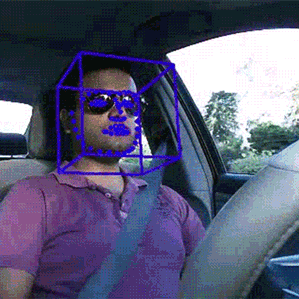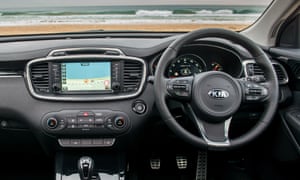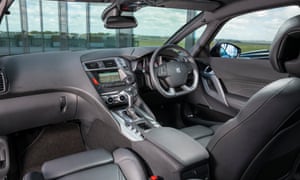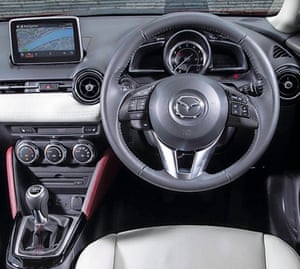On the road: Mitsubishi L200 Barbarian – <b>car review</b> | Technology <b>...</b> |
- On the road: Mitsubishi L200 Barbarian – <b>car review</b> | Technology <b>...</b>
- On the road: Kia Sorento – <b>car review</b> | Technology | The Guardian
- Mercedes-AMG G63 6x6 <b>Review</b> | Autocar
- DS 5: <b>car review</b> | Martin Love | Technology | The Guardian
- A <b>Car</b> That Knows What the Driver Will Do Next | MIT Technology <b>...</b>
- On the road: Mazda CX-3 – <b>car review</b> | Technology | The Guardian
| On the road: Mitsubishi L200 Barbarian – <b>car review</b> | Technology <b>...</b> Posted: 02 Oct 2015 10:00 PM PDT Mitsubishi L200 Barbarian. The Mitsubishi pick-up has "Barbarian" in lights across every conceivable surface. It is incredibly beefy and, in the wrong hands, indeed a barbarian. You could back into an innocent Zafira as easily as turning on the radio. The parking camera is worse than useless, slow to respond and, in consequence, wrong about almost everything. But you don't get a pick-up because it's easy to park. You get it if you need to pick up a lot of stuff. It's too large to get into a city dump without a licence, so it's not your amateur's pick-up. This is a planner's pick-up. In rear-wheel drive, it is a bit like a tractor. The gear stick carries on shaking as you turn off the engine. It makes so many noises, I kept thinking there was a police car behind me. "Even the windows are too loud," said a haughty seven-year-old from the back. Modern cars, I realised, try to mask the raw mechanics, and there is none of that here. Anything you can't hear, you can feel vibrating. Primary ride events come at you like a fairground attraction: if you can see a crater coming, you know you're going to feel it. But secondary ride events are significant, too: a seam in the road you wouldn't even see will knock you around like a squally wind. It's like driving a shed. "Why are these cowardly cyclists scattering before me?" I asked my mister. "Have you seen the size of yourself?" he replied. Indeed, it's so heavy that the determining factor in performance is not engine size but gravity: going down the slightest incline, you can be in fourth at 20mph and not even feel it. Going uphill, you have to floor it in third just to get on to a slip road. I was so high up in the cabin, I was at eye level with white vans and other pick-ups. You sort of acknowledge each other – it's hard not to – and I nod, trying to imagine what it would be like if I really were working. Apparently, these are very popular with American agents (it's an ironic thing: "Any normal person would be in a Hummer; we could afford one, but prefer this") and with Islamic State (along with the Toyota Hillux and Mitsubishi Warrior). In the absence of a higher ironic purpose or an ideological war, it made sense to me only with a party of 10-year-olds on the flatbed, screaming their way around a car park in Surrey Quays (which I definitely did not do, but was hypothetically hilarious). It is neither a city car, nor a country car. It's a working car, like a working dog: not as charming as a regular one, but more impressive. Price £28,558.80 |
| On the road: Kia Sorento – <b>car review</b> | Technology | The Guardian Posted: 25 Sep 2015 10:00 PM PDT The Kia Sorento is the kind of car that will cause acquaintances to ask, "What are you driving now?" when you arrive. If you like that kind of thing – and God knows, I love it – you'll burst with pride. It has a slightly militaristic exterior, more imposing in black, I should think; in white more redolent of plain money. It's long, wide and low, spacious inside, bullish on the road. There are potentially three rows of seats, though I never needed them and left the boot as was. As low as it is, the boot is an extremely high jump for an elderly dog, not that I would ever put a dog in his twilight years in a review car, oh no. City driving, as with anything not designed for a city but that city people love to drive, is not ideal: it's sluggish in the lower gears. If you're in first and second a lot, you may feel vexed by the effort. But cruising is a pleasure: give it an A road or a motorway and it will take care of itself. The acceleration is confident, the steering is true, the traction is reassuring, the handling invites trust, the leather seats make you feel as though everything's going to be OK. The driving position is well thought-out, everywhere from the posture to the armrest. The room in the cabin really tells if you're one of those people who lurches into a car with two litres of water and a load of handheld devices you forgot to charge. The satnav, from its classy 8in screen to the intuitiveness of its controls, is a pleasure: it is one of the injustices of the world of cars that you feel moved to comment on satnav only if it sucks. Then, once in a while, it's great, and you remember to mention it. It is the first time, by popular lore, Kia has ever come up with anything you'd want to spend 30 grand on, so they're naturally pretty proud. 0-62mph in nine seconds is quite fun, though you never feel as though you're taking off. It has the safety features du jour, which revolve mainly around an insane number of airbags and a lot of alarms – blind spot, lane discipline and rear cross traffic alert (this translates in the real world into a noise you don't understand, until the hazard passes you or recedes) – and the fuel consumption is decent. The question is, would you fall in love with it? If you think of SUVs as a bid for status, then a moderately priced one would seem pointless. But if you genuinely need a giant car that a dog can't get into or out of, then it's a good, solid, novel entry into the class.
Price £35,845 |
| Mercedes-AMG G63 6x6 <b>Review</b> | Autocar Posted: 28 Feb 2013 09:37 PM PST This is the lunatic six-wheel Mercedes G63 AMG 6x6, the largest and most extreme road legal SUV to ever hail from Mercedes' road car operations. Produced on a limited basis – and at a price of £370,000 – the colossal double-cab pickup started life as an even more rugged military version of the G320 CDI conceived and engineered for the Australian army and in operation since 2011. This plush, leather-lined civilian version of the off-road vehicle has been conceived to appeal to some of Mercedes-Benz's most affluent clientele. It features six driven wheels, low range gearing, five differential locks and a tyre control system for its standard 37-inch wheels. Mercedes says it is "the last word in forward-thrusting power for the beaten track". Unlike the military version of the G320 CDI 6x6, which is fitted with Mercedes-Benz's 3.0-litre V6 diesel and is offered in outputs of up to 220bhp, the G63 AMG 6x6 gets a twin-turbocharged 5.5-litre V8 from AMG with 536bhp. Torque is a 560lb ft – crucial in providing the shove required to haul the big four-seater's considerable 3775kg kerb weight. Mercedes' 7G-tronic seven-speed automatic transmission is fitted in place of the old NAG1 five-speed auto 'box found on the army version. Its transfer case can alter between a 0.87:1 high-range ratio for on-road driving and 2.16:1 low-range ratio for off-road conditions to all six wheels in a nominal 30:40:30 split. Power for the rearmost axle is supplied by an extra shaft. There are five electronic differential locks offering 100 per cent lock up of all six wheels, operated by three switches on the dashboard. Relaying the engine's strong reserves to the ground are massive 37-inch wheels featuring a bead-plate design. They are shod with 12.5in-wide wheels. At 5875mm in length, 2110mm in width and 2210mm in height, the G63 AMG 6x6 is 1106mm longer, 225mm wider and 272mm higher than the G63 AMG. Along with a 300mm increase in the wheelbase through to the middle axle at 3120mm, the front and middle axles have increased in width by 281mm each at 1790mm, requiring widened and lengthened carbonfibre guards to cover the huge wheels. Ground clearance is a whopping 460mm while fording depth is put at 1000mm – some 250mm and 400mm more than the standard car. Approach and departure angles have been increased by 16 degrees and 27 degrees at 52 degrees and 54 degrees respectively, while the breakover angle has increased by 1 degree at 22 degrees. To drive, it's a blast, at least in the wide-open space of a Dubai desert where the G63 AMG 6x6 has sufficient room to strut its stuff. I'm not sure how it would fare during the morning rush hour, but there's no doubt you'd be noticed. And really, that's what this new Mercedes-Benz is all about. That said, the example we drove was terrifically engineered – as complete from a technical standpoint as you'd expect any model from the German car maker whose first 6x6 customer deliveries are planned to get underway in just six months' time. Before we got behind the wheel, we were taken for a wild ride over the dunes by a Mercedes test driver, who performed a round of donuts to prove how well engineered the G63 AMG 6x6 really is. The fact that it was originally conceived for military use helps, of course. The big surprise is just how refined it is. Once you've heaved yourself on to the substantial step plate and introduced your backside to the leather-lined comfort of the G63 AMG 6x6's heavily contoured sport seat, you discover a cabin changed little from the standard G63 AMG up front. The upright driving position is old school, as is the steeply angled windscreen and shallow dashboard. But forward vision is brilliant and indicators mounted on the front fenders act as positioning points. Rear vision is hampered by the tall rear seatbacks and a small two-piece sliding rear window. At 3120mm, there's a 300mm increase in wheelbase to the first of the rear axles. It provides a longer cabin than the standard G63 AMG – and with it additional rear legroom. There's a liberal covering of Alcantara throughout and the standard three-across rear bench seat is replaced by two individual AMG sport seats. They get electronic backrest adjustment and are divided by a rear centre console. There's an engaging blare through the four sidepipes as you hit the starter button to fire the engine, lending the big Mercedes an eager demeanour. Blip the throttle and it squats on its springs under load change like a true muscle car. Once underway, the G63 AMG 6x6 proves remarkably easy to drive. It may have been conceived for the rough-and-tumble of army duties in the Australian outback, but the work put in to converting it for civilian use has produced a straightforward nature together with level of comfort you'd hardly credit from such an extreme-looking machine. In the dunes of the Dubai desert, the G63 AMG 6x6 feels invincible. Those big tyres work with the complex driveline to provide plenty of traction, allowing you to wind it up to regular motorway speeds on narrow sandy tracks without any great trepidation. It cruises with great authority, providing longitudinal stability – far better than the regular G63 AMG owing to the longer wheelbase and added traction provided by the third axle. There's far less vertical movement through the suspension than the standard car, resulting in a surprisingly smooth ride. There's plenty of lean in corners, but body movements are controlled thanks to a unique spring and damper package developed specifically for the G63 AMG 6x6. Despite its weight, it accelerates with great vigour. Heady torque combines with the traction-enhancing qualities brought by the six-wheel-drive system to deliver impressive off-the-line and in-gear qualities. Mercedes won't quote official acceleration claims just yet, but insiders suggest 0-62mph in less than six seconds. Top speed, limited by its balloon-like tyres, will likely be electronically governed to 100mph. And consumption? Again, Mercedes is yet to publish official figures, but we're told to expect around 15mpg on the European test cycle. It's just as well that the G63 AMG 6x6 will come with two fuel tanks with an overall capacity of 159 litres. The prototype's vague, hydraulically-operated steering, which is geared at a lazy 3.4 turns lock-to-lock, indicates the need for some fine-tuning to better suit the big tyres. But any doubts about dynamic ability on the back of its rugged good looks were quickly dispelled. Even when confronted with steep dunes and daunting sink holes, the hulking SUV managed to take it all in its stride, powering on with determination and a baritone exhaust note. Excellent wheel articulation and myriad diff lock combinations keep all six wheels firmly planted on the ground for impressive progress. An onboard compressor with four 20-litre tanks fitted along the sides of the underbody allow you to adjust tyre pressures, taking just 20sec to increase from a stand-friendly 0.5bar up to the 1.8bar required for on-road use – much faster than a conventional system that typically takes around 10mins. The only thing I've driven that comes remotely close to the feeling I got while at the wheel of the G63 AMG 6x6 is the Hummer H1. But while the former is incredibly nimble for something so vast and hugely powerful, the latter was stodgy and rather lethargic. You could argue long and hard about the merits or otherwise of the G63 AMG 6x6 – surely the world's first road legal MUV (monster utility vehicle). However, one thing holds true: it is a fun thing to drive in the right conditions. But with a price tag more than three times that of the G63 AMG, it is going to be a super-exclusive proposition for all but the mega-rich. |
| DS 5: <b>car review</b> | Martin Love | Technology | The Guardian Posted: 26 Sep 2015 10:00 PM PDT On the road: the DS 5, built with the air of a grand tourer. Photograph: Daniel Pullen Price: £25,980 The birds that perch in the trees opposite my house are not fans of the new DS 5. They made their displeasure clear with a night of strategic bombing. God only knows what they'd been gorging on, but they created a proper splatterfest. One of those you end up scraping at with a thumbnail. And I sort of agreed with them – not that I'd have expressed it in the same way. Some cars are so much more photogenic than others. In pictures the DS 5's high bonnet and swirling chrome detailing give the impression of a nicely balanced vehicle, surging athletically up the road. But in the flesh it looks awkward: its bonnet and vast sweptback windscreen too big for its body, like one of those egg-headed dogs Princess Anne is so fond of.
I haven't mentioned the C-word yet because, despite what you might think, this is no longer a Citroën. DS split from its parent company last year and its double chevron has now been replaced with a sinuous D kissing a flirty S. Launched 60 years on from the original DS, which still captivates with its curves and ingenuity, this DS probably won't be celebrated in quite the same breathless way in 2075. However, DS is keen to establish itself as a constructor of premium cars which stand out from the crowd, and it has made every effort to combine ambitious styling with good comfort, dynamic technology and a decent engine. Step in and you'll find an interior which is quirky and different, but not always in a good way. The seats are strikingly padded with leather blocks which look both retro and modern – especially in the Toffo-tan colour mine was. The dashboard is clutter-free thanks to half the buttons having migrated to a central strut overhead between the twin sunroofs (there's also a third glass panel above the back seats). But rather than feeling light and airy, the interior feels oddly claustrophobic and unsettling.
The 1.6-litre BlueHDi diesel which I tested is economical and superbly quiet. You might be underwhelmed if you wanted to hare round corners, but on a long cruise it's admirably unflustered and the fuel economy is excellent. The steering wheel feels big in your hands, which goes against the trend for smaller, sportier styles. Speed bumps are a tiresome issue round me – though not for my wife, who happily slams over them, bouncing the rear axle sickeningly into the air. I once persuaded the kids in the back to wear their cycle helmets to make a point, but that only encouraged her. However the DS 5, with its upgraded suspension, coped brilliantly, easing gracefully over every sleeper. However I'm not sure this new car will enjoy as smooth a ride further down the road. Email Martin at martin.love@observer.co.uk or follow him on Twitter at @MartinLove166 |
| A <b>Car</b> That Knows What the Driver Will Do Next | MIT Technology <b>...</b> Posted: 30 Sep 2015 09:00 PM PDT Researchers trained a computer to recognize the behavior that precedes a particular maneuver.  An experimental new dashboard computer can not only keep track of your behavior behind the wheel, but even predict what you're about to do next. With the vast majority of road accidents resulting from driver error, and distraction a growing problem thanks to the ubiquity of smartphones, carmakers are increasingly exploring ways to track driver behavior behind the wheel. Volvo, GM, and others are already testing systems that will monitor head and eye positions to pick up on signs of distraction. A study by researchers at Cornell University and Stanford shows that a more advanced system could be trained to recognize the body language and behavior that precedes a particular maneuver. This could help trigger an early warning system, such as a blind spot alert, much earlier—perhaps thereby helping to prevent serious accidents, according to the academics involved. "Imagine you are driving on a highway," says Saxena Ashutosh, the director of a project called Robo Brain at Cornell University and Stanford who oversaw the driving project. "You look to the right for a second, because you are going to make a right turn, and as you are starting to make a right turn, some other driver has pulled into the space that you thought was empty." A car could then either issue an alert or even prevent you from pulling into the lane. The system was trained using cutting-edge machine-learning algorithms, and it could predict, with just over 90 percent accuracy, when a driver was about to change lanes in the next few seconds. A lane change was usually signaled by a glance over the shoulder along with telltale head movements and changes in steering, braking, and acceleration. Ashutosh says the accuracy achieved is almost good enough to be used in a production system.  This video shows the features used by the system to track a driver's head movement. The researchers behind the work are exploring different ways for a vehicle to monitor and anticipate driver behavior through a project called Brain4Cars. The work involved using a machine-learning approach called deep learning to recognize the actions that preceded the lane-change maneuver. The algorithms were trained using data collected as 10 different people drove a total of 1,180 miles around different areas of California. The researchers intend to make the resulting data set freely available so that other academics and auto researchers can make use of it. Deep learning has proven especially useful in recent years for recognizing complex or subtle patterns in data such as video and audio (see "10 Breakthrough Technologies 2013: Deep Learning"). It is already used to enable vehicle computers to recognize different types of obstacles on the road. In the latest work, the team combined data from a video camera with GPS data and information from a car's computer systems. Many luxury cars now come with sensors that enable safety warnings, as well as automatic breaking and steering. Ashesh Jain, a student of Saxena's and project lead on Brain4Cars, says monitoring activity inside a car, as well as outside of it, could make such safety systems more intelligent. "Suppose the driver is distracted for a second," he says. "If there's nothing in front, the car should be smart enough, and not alert the driver. It's about how you use information from all these sensors." More than 90 percent of U.S. road accidents are the result of some sort of driver error, according to research conducted by the National Highway Traffic Safety Authority. Paradoxically, monitoring driver behavior could become more important even as cars become more automated. That's because even if cars drive themselves in some situations, such as on highways or in parking lots, drivers will still need to retake the wheel occasionally, and research has shown that this can take many seconds depending on a driver's level of distraction (see "Proceed with Caution toward the Self-Driving Car"). Google has gone so far as to sidestep the problem by removing the pedals and steering wheel from some of its prototypes altogether. Don Norman, an expert on product design who has served as a consultant for numerous carmakers and computer companies, says the Brain4Car work is promising, but adds that it will need to be improved further and tested in the real world. "These are simulation data, run in the laboratory," Norman says. "The real world is never as nice as the laboratory. Many factors may change the results when applied to real people driving real cars in real traffic." Gain the insight you need on emerging technologies at EmTech MIT. Register today  |
| On the road: Mazda CX-3 – <b>car review</b> | Technology | The Guardian Posted: 18 Sep 2015 10:00 PM PDT Mazda CX-3. They say the compact crossover is a crowded market, but that's only in the sense that any market loosely defined (futures, greeting cards, animal fats) looks crowded. What exactly is the Mazda CX-3? The thing that is larger than the Mazda 2, or the thing that is smaller than the SUV? It's the latter, of course, because everyone loves the word "SUV", but it isn't large enough, least of all in the boot capacity, to warrant the term, even if it technically skims it. The upside is that it looks neat and sharp. They are funny, Mazda, full of high design concepts: "Kodo" is the unified look across the styles. The CX-3 meets it by being aggressive yet sleek around the nose, tidy through the body, sheered off neatly at the back. Skyactiv is the technology, which they illustrate with a video that pits a CX-3 against a greyhound. It is weird nobody pointed out that most cars are faster than dogs. Anyway, because it is attractive on the outside, and on the inside has leatherette seating with red piping, and because its variant is "Sport Nav diesel", you expect a thrill. At 10.1 seconds to do 0-62mph, its getaway speed is tasty; it feels much more alive than the Dacia Duster, the other big beast (popularity-wise) in this class. Sometimes nippy cars don't accelerate well in the middle gears, but this was pleasant in all of them, and cruised well. Someone I am acquainted with by marriage complained that the fascia on the doors was the wrong height to lean your elbow on and get a tan on your arm, but otherwise, both driver and passenger position were comfortable. In the cabin, things were spacious and there were likable features; for some reason, the leather-effect stick shift area really pleased me. The touchscreen multimedia system is good on paper but lacks finesse, claiming mid-journey that satnav hadn't been installed after all. The intuition quotient was high, though: there wasn't anything I couldn't guess, except where the seventh speaker was. (Nice to have so many of these, by the way. It got pretty loud, which I like in a car, especially when I don't know where I'm going.) The ride is a bit bouncy and unpredictable – enough to make you think more about suspense than suspension. It's a bit unfair to talk about primary ride when you take a car to a festival, but it was even a bit of a prima donna when it came to a seam in the tarmac. Melodrama was the only dramatic thing about it; it was sometimes admirable for its competence, but not showstopping.
Price £22,435 |
| You are subscribed to email updates from car review - Google Blog Search. To stop receiving these emails, you may unsubscribe now. | Email delivery powered by Google |
| Google Inc., 1600 Amphitheatre Parkway, Mountain View, CA 94043, United States | |





No comments:
Post a Comment